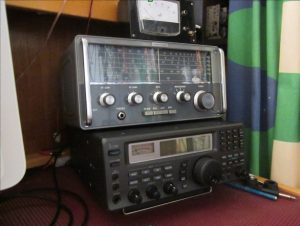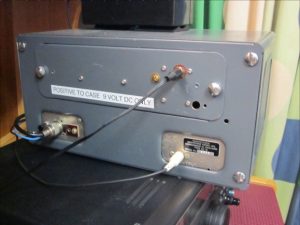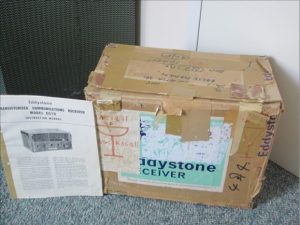My Eddystone EC 10 Transistor Communication Receiver January 1970 – to ???
Interesting anecdote from EUGer Roger Tricket about his lifetimes experience with his much loved Eddystone EC10 receiver
In 1969 I was posted to a position in New Guinea, so took delivery in Melbourne early Jan 1970 of a new Eddystone EC 10 Serial 6605. It has been to New Guinea, Indonesia, Saudi Arabia, England, Thailand and a number of locations in my home country, Australia.

EC10 above ICom 8500
It has been turned on continuously since new apart from periods in transit, so now in 2024 it seems it would have been on for all of about 50 years of its 54 year life (2024).
Still used every day for a shortwave broadcast I like and as in all those years when not listening, I turned down the audio, but leave the set running. It has generally been fed from 20 – 30 ft aerials, sometimes thru a mini aerial tuner. Now wire aerial through 1 to 1 toroid transformer into coax to the set. (note the station closed about 2020). Now in general use but always on tuned to WWV.

WWV freq on dial
Alterations – replaced all electrolytic capacitors about 2015; the agc line cap now uses a bipolar cap as there was a question relating to the circuit polarity, it works better now. When adjusting the mixer trimmer with metal shaft screwdriver, it shorted and killed the mixer transistor, which has been replaced from a stock of replacements I keep ( these have the leads wound together in attempt to avoid the dreaded whiskers ).

Rear view with power and antenna connections
The power supply is a 9v plug pack and fed to an 8v voltage stabiliser built into the case about 2016. However for some 30 years it was fed with voltages from various sources 6v to 12v and even a standard mini 9v battery, on which it will run for several hours. Note: set runs positive to earth so cannot use common power supply with other equipment – the plug pack has negative to earth so reversal is done in the voltage stabiliser which uses feed in from an isolated input plug; see pic.
The aerial terminal was replaced with a coax fitting ( for 50 Ohm line ) which feeds an internally mounted mini toroid balun – 50 to 75 Ohms so the twin diodes are removed. The BFO injection Capacitor was increased to 3PF. As a signal strength meter I use a 100 Microamp meter direct into the audio out socket as this carries the AGC voltage in the original wiring from the factory.

Original box and instructions
Compared to a modern Icom R8500 receiver it does a very credible job, though frequency drifts notoriously with daily temperature changes!
It is now 2024 and I am in my mid 80s so with luck it will outlast its owner………
Compared to a modern Icom R8500 receiver it does a very credible job, though frequency drifts notoriously with daily temperature changes! It is now 2024 and I am in my mid 80s so with luck it will outlast its owner……
Interesting note of relevance – Nasa used these same germanium transistors in early space exploration and it has been found “whiskers” grow in the RF metal case transistors and kill them. There is a document available where Nasa explores this subject. Hence this set needs to run continuously which seems to avoid the problem.
Note – In 2021 the on off power switch in the RF gain control failed and there is now a mini switch on the rear.
Roger Trickett
